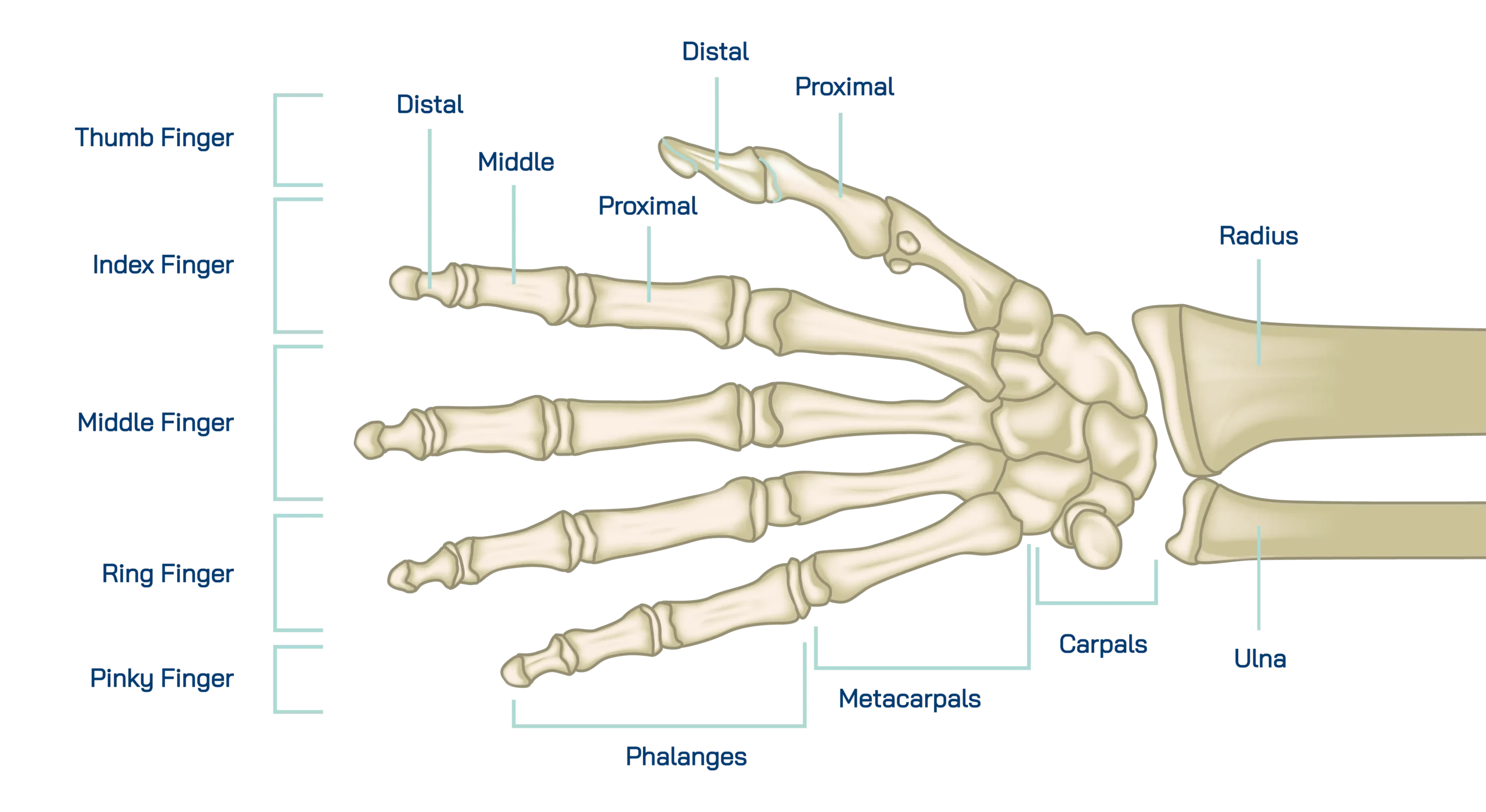Hand & Wrist Disorders
Introduction to Hand & Wrist Disorders
The hands and wrists play an essential role in nearly every aspect of daily life. From buttoning a shirt to lifting a cup of coffee, we rely on these joints for both delicate and strong movements. When something goes wrong in the hand or wrist, even simple tasks can become painful or difficult.
Dr. Ray B. Jensen is an orthopedic surgeon in Meridian, ID who specializes in diagnosing and treating hand and wrist disorders. He works closely with each patient to explore treatment options, discuss goals, and create a personalized care plan. You can expect shared decision-making every step of the way.
(208) 900-5633
6357 N. Fox Run Way,
Meridian, Idaho 83646
Monday - Friday | 8:00 AM - 5:00 PM
Dr. Jensen's Services
Hand & Wrist Anatomy
The hand and wrist are made up of many small parts that work together to allow precise and powerful movements. These include bones, joints, muscles, tendons, ligaments, and cartilage.
The wrist connects the forearm to the hand and contains eight small bones arranged in two rows. These bones form joints with each other and with the long bones of the forearm. The hand itself includes the metacarpal bones and the fingers, which are made up of phalanges.
Tendons connect muscles to bones and allow movement. Ligaments hold bones together and provide stability. Cartilage acts as a cushion between bones to help the joints move smoothly. Nerves and blood vessels travel through this area and are responsible for sensation and function.
Because the hand and wrist are used so often and have such a complex structure, they are prone to injury and wear and tear over time. Repetitive use, arthritis, trauma, and nerve problems can all lead to pain and dysfunction in this area.

Common Hand Disorders
The hand is responsible for fine motor tasks and grip strength. With so many joints, tendons, and small bones working together, the hand is sensitive to injury and wear. Below are common conditions that affect the hand specifically.
Trigger Finger
Trigger finger happens when a tendon in the finger becomes irritated and cannot glide smoothly. This can cause the finger to get stuck in a bent position and then suddenly snap straight.
It is often caused by overuse or inflammation around the tendon. People may notice stiffness, popping, or pain when moving the finger. Treatment may include rest, splinting, and corticosteroid injections. If these do not help, a simple surgery can help release the tight area.
Hand Fractures
Fractures in the bones of the hand can result from falls, sports injuries, or accidents. A broken hand can cause swelling, bruising, and difficulty using the hand.
Depending on the severity, treatment may include a splint, cast, or surgical repair to realign the bones. Physical therapy may follow to restore strength and movement.
Thumb Arthritis
Arthritis at the base of the thumb is a common condition, especially in older adults. It often causes pain with gripping or pinching and may lead to weakness or swelling.
Wear and tear of the cartilage over time leads to this condition. Early treatment includes splints, pain relief methods, and hand therapy. If arthritis becomes more severe, surgery may be an option to improve comfort and function.
Tendon Injuries
Injuries to the tendons in the hand can occur from deep cuts, sports injuries, or sudden force. This can affect the ability to bend or straighten the fingers.
Treatment depends on the type of injury. Some tendon injuries can heal with splinting and therapy. Others may require surgery to repair the damaged tendon, followed by a structured rehabilitation plan.
Dupuytren’s Contracture
This is a condition where tissue in the palm thickens over time, causing the fingers to slowly bend inward. It most commonly affects the ring and little fingers.
The cause is not always clear, though it may be linked to family history. Mild cases may only need observation. If hand function is affected, treatment can involve needling procedures or surgery to release the tightened tissue.
Common Wrist Disorders
The wrist allows the hand to bend, twist, and bear weight. Because of its frequent use and complex structure, the wrist is vulnerable to repetitive strain and trauma. Below are conditions commonly affecting the wrist.
Carpal Tunnel Syndrome
Carpal tunnel syndrome is a condition that affects a nerve running through the wrist. When the space inside the wrist becomes too tight, it puts pressure on the nerve, leading to pain, numbness, or tingling in the hand and fingers.
This condition often develops from repetitive hand motions or certain health conditions. Symptoms may feel worse at night or during activities like typing. Treatment may include wrist splints, activity changes, or anti-inflammatory medications. In some cases, surgery may be needed to release pressure on the nerve.
De Quervain’s Tenosynovitis
This condition affects the tendons on the thumb side of the wrist. It causes pain, especially when making a fist, gripping objects, or turning the wrist.
It is often linked to repetitive wrist motions such as lifting a baby or using a keyboard. Treatment may involve rest, a thumb brace, and physical therapy. In more severe cases, a surgical release of the tendon covering may be needed.
Wrist Sprains
A wrist sprain occurs when the ligaments in the wrist are stretched or torn. This can happen from a fall or sudden twist.
Symptoms include pain, swelling, and trouble moving the wrist. Treatment usually involves rest, ice, and a brace to support healing. If the injury is severe or the ligaments are torn completely, surgery may be recommended.
Wrist Arthritis
Arthritis in the wrist can develop over time from wear and tear or after previous injury. It may cause pain, stiffness, and reduced range of motion.
Treatment often starts with lifestyle changes, splints, and anti-inflammatory medicine. If symptoms do not improve, surgery may be considered to clean the joint or fuse certain bones to reduce pain.
Ganglion Cysts
These are benign lumps that often appear on the back of the wrist. They can vary in size and may come and go.
Ganglion cysts are filled with fluid and are usually harmless, though they can cause discomfort or limit motion. Treatment may include observation, draining the fluid, or removing the cyst if it interferes with wrist use.
Treatment and Recovery
Dr. Jensen takes a thoughtful and personalized approach to treating hand and wrist disorders, offering both non-surgical and surgical options tailored to your condition, lifestyle, and goals.
Non-Surgical Treatments: Rest, ice, activity modification, bracing, and anti-inflammatory medications are often effective for reducing pain and improving hand or wrist function. Physical therapy may be recommended to restore movement and strength. In some cases, splints or corticosteroid injections can help relieve pressure or inflammation.
Surgical Treatments: Certain conditions, such as tendon injuries, fractures, advanced arthritis, or nerve compression, may require surgery. Procedures may include tendon repair, joint stabilization, fracture fixation, or carpal tunnel release. Dr. Jensen discusses all options carefully so you can make informed decisions with confidence.
Recovery and Prevention: Recovery plans focus on gradually restoring motion, strength, and function. Physical therapy often plays a key role in the healing process. Preventive strategies, such as proper ergonomics, hand exercises, and avoiding repetitive strain, can help reduce the risk of future problems.
Hand and wrist disorders can affect your daily comfort and independence, but many treatment options are available to help you heal and regain control. Whether you are recovering from an injury or managing a chronic condition, Dr. Jensen works closely with you to create a plan that fits your needs. His goal is to help you return to the activities you enjoy with less pain and greater confidence.



